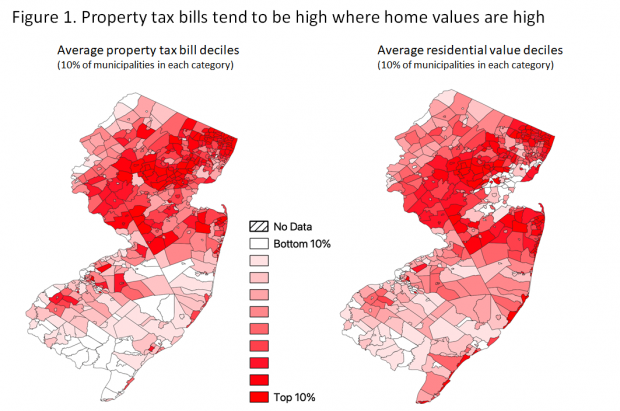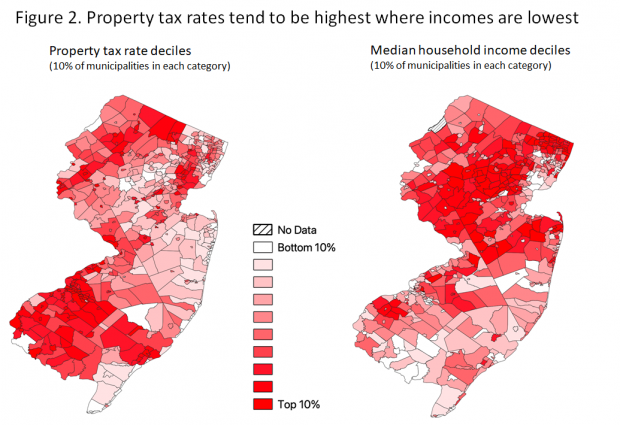New Jersey Future Blog
Where Do New Jersey’s Property Tax Bills Hit the Hardest?
February 15th, 2021 by Tim Evans
Recently-released property tax data from the Department of Community Affairs have reminded us once again that New Jerseyans pay a lot in property taxes. Indeed, New Jersey residents pay the highest property tax bills in the country—a median of $8,432 as of the 2019 American Community Survey1. No other state comes close; second-place Connecticut’s median real estate tax bill is $6,004, more than 25% lower than New Jersey’s. In general, the other states near the top of the list (New Hampshire, New York, and Massachusetts round out the top 5) are other Northeastern states that are heavily reliant on property taxes for generating government revenue.
It’s Not the Size of the Bill
Most media coverage tends to misdiagnose where property taxes inflict the most pain, focusing on the absolute amount of the bill. Property tax bills, unsurprisingly, tend to be highest where property values are highest (see Figure 1). Among the top 10 municipalities with the highest average tax bills—Tavistock, Millburn, Mountain Lakes, Tenafly, Demarest, Glen Ridge, Rumson, Alpine, Essex Fells, and Princeton—all have average residential values of more than $600,000 (compared to the statewide average of $330,578), and in half of them the average home value is more than $1 million. Four of them2 are also in the top 10 municipalities with the highest median household incomes. Property tax bills are high in communities with high property wealth because such places value high-quality government services and are willing and able to pay for them. High property tax bills that result from high home values thus do not necessarily constitute a problem.

High Values, Low Rates
The picture changes with a different perspective on what it means to pay “a lot” for property taxes. Specifically, where are property tax rates the highest? Not in the places with the biggest average tax bills, or the places with the most expensive homes. Among the 50 municipalities with the highest average tax bills, the median property tax rate is 2.163%, compared to a median rate of 2.614% over all other municipalities. Of the 50 municipalities with the highest average home values, more than half (26) are among the bottom 50 with the lowest tax rates. When a town’s homes are expensive, it doesn’t have to tax at a very high rate to raise a lot of money to pay for government services.
Highest Rates in Low Income Communities
Instead, high property tax rates are found most consistently among municipalities where incomes are lower. The list of the 10 municipalities3 with the highest tax rates—Woodlynne, Salem, Penns Grove, Hi-Nella, Trenton, Egg Harbor City, Pleasantville, Irvington, Lindenwold, and Laurel Springs—differs dramatically from the earlier list where the tax bills are highest (and where tax rates tend to be among the lowest). All but one of these places rank in the bottom 50 municipalities with the lowest median household incomes, and four of them have median incomes that are less than half the statewide median. Among the 50 municipalities with the lowest median household incomes (all less than $57,000, compared to a statewide median of $82,545), the median tax rate is 3.185%, substantially higher than the median of 2.523 percent over the rest of the state’s municipalities. The places with high property tax rates—where property tax bills take a bigger bite, proportionally speaking—are not, by and large, wealthy places.

New Jersey does indeed have a property tax problem, but it’s a much bigger problem for low-wealth communities than for wealthy ones. In the mostly lower-income places where tax rates are highest, property taxes place a huge burden on the households and businesses that are located there and discourage new residents and businesses from moving in. Similarly, it makes it more difficult to jumpstart new redevelopment and revitalization efforts since the newly constructed projects will carry an outsized property tax bill. These places ought to be part of the discussion and are the places on which any effort at tax reform should be focused.
1 Data from the American Community Survey are derived from a sample, so values will not match up precisely with data from the NJ Department of Community Affairs, which collects full property tax data from every municipal government in the state. The ACS is useful for comparing states to one another, however.
2 For confidentiality reasons, the Census Bureau does not publish median household income data for Tavistock, which has a total population of only 5 people.
3Excluding Winfield and Audubon Park, where historical non-standard homeownership models make statistics on home values and tax rates not directly comparable to other municipalities.
Related Posts
Tags: New Jersey, property tax bills, tax data, taxes
















